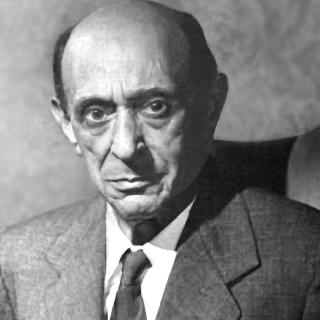
This month we are presenting a performance of a classic piece from the new music repertoire, Arnold Schoenberg's "String Trio". This piece will be performed by Terrie Baune (violin), Ellen Ruth Rose (viola), and Thalia Moore (cello). This performance will be accompanied by commentary from Bruce Christian Bennett and the performers. This performance will be premiering live on our YouTube channel at 7pm (PST).
ARNOLD SCHOENBERG:
Arnold Schoenberg (1874-1951) was born in Vienna, Austria in 1874 into a middle-class Jewish family. In his youth, he played cello and was passionate about Viennese musical culture. Though he had no formal training in composition, according to his own admission, he did receive tutoring in counterpoint from his close friend and future brother-in-law Alexander von Zemlinsky (who had studied at the Vienna Conservatory with Fuchs and Bruckner).
In his earliest works, Schoenberg wrote in a sophisticated, almost hyper-romantic style, a fusion of intricate Brahmsian thematicism and rich Wagnarian chromaticism. From very early in his career, he was a controversial figure. His tone poem Verklärte Nacht, Op. 4 for string sextet (1899) was dismissed from a composition contest by the conservative judges of the Viennese musical establishment for having an invalid chord (an inverted ninth chord), which we now understand to be simply the result of his evolving countrapuntal techniques. Schoenberg’s compositional technique of constant motivic development and variation would eventually lead him to move beyond 19th-century tonality into a completely chromatic harmonic language, referred to by his critics as atonality.
His works Op. 11 and on eschew traditional tonality for total chromaticism. He would refer to this move in his substantial book on harmonic theory, Harmonielehre (1922), as the emancipation of the dissonance—the notion that those intervals that where previously considered dissonant are only more remote consonances in the overtone series.
One of the more challenging aspects of Schoenberg’s music is not simply its move from diatonicism to chromaticism, but also his rhythmic evolution from common periodic phrase structures to aperiodic phrase structures as well as overlapping polyphonic phrasing. One of his star students, Alban Berg, explores this question in his 1924 essay, "Why is Schoenberg’s Music So Difficult to Understand?" Berg contends that it is the constant development of the thematic and motivic material that necessarily leads to these complex rhythmic structures, and that music without much literal repetition and rhythmic regularity is inevitably challenging to most adherents to Viennese Classicism, and yet those willing to make the extra effort to engage this music will be richly rewarded.
STRING TRIO Op. 45:
for violin, viola and cello
The music department of Harvard University commissioned the String Trio and the Walden String Quartet premiered it in 1947. Schoenberg composed most of the piece a few weeks after suffering a severe heart attack. He was seventy-one at the time; he died five years later.
It is said that this Trio reflects the pain of the attack itself and Schoenberg’s repose during his recovery. This could be said to be the program of the Trio, though the composer resisted programmatic interpretations of his works. On a higher level of abstraction, the work is about the struggle between life and death.
Using intense expressionistic gestures, neoclassical references, and a virtuosic deployment of his twelve-tone method of composing, Schoenberg piles up musical ideas, disrupts their continuity, displaces or disallows musical consequences, and breaks off stabilities of phrase, color, range and rhythm (see M. Cherlin’s Memory and Rhetorical Trope in Schoenberg’s String Trio). His use of a large palette of string techniques is particularly prominent: plucking the strings (pizzicato), striking them with the bow, playing close to the bridge or the fingerboard of the instrument, using the wooden part of the bow, playing on more than one string simultaneously, sliding a finger along a string to change the pitch smoothly, lightly touching the strings to make them play high glassy pitches, rapidly moving the bow back and forth (tremolo) or alternating between two pitches, and employing large intervals and extreme shifts of loudness. Using these and other techniques, Schoenberg fills the piece with extreme contrasts and non sequiturs.
The piece consists of five sections that flow together into one large form. It has been characterized as a sort of sonata form. After a couple of minutes, the loud frenetic material of the opening leads to quiet tremolos followed by an isolated high pizzicato and the end of the opening material. The slow, quiet, almost tonal material that comes next can be heard as a secondary theme. Development follows and after about fifteen minutes one hears a modified recapitulation of the opening themes, including the tremolos and the high pizzicato. The piece lasts nearly twenty minutes before it quietly fades away with a few beautiful tone rows.
By presenting phrases that never find closure and implying harmonies that never resolve, by using forms that distort the usual proportions, by contrasting waltz rhythms and short song-like melodies with jagged distortions of the sound material, and by making oblique allusions to extra-musical realities such as dance history or the techniques of Beethoven’s late works, the Trio "insists on its own imperfection, and therein lies its greatest triumph" (Cherlin). Schoenberg avoids the closure and perfection that symbolize death itself.
Program Items
Arnold Schoenberg
String Trio Op. 45
Performers
Terrie Baune
Violist
Ellen Ruth Rose
Violist
Thalia Moore
Cellist
